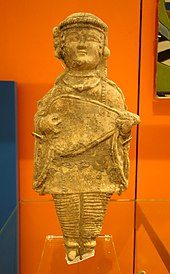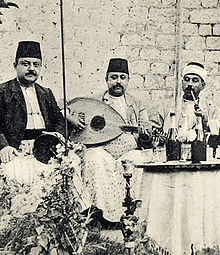Oud
[8] An early description of the "modern" oud was given by 11th-century musician, singer and author Al-Hasan Ibn al-Haytham (c. 965–1040) in his compendium on music Ḥāwī al-Funūn wa Salwat al-Maḥzūn.
The first known complete description of the ‛ūd and its construction is found in the epistle Risāla fī-l-Luḥūn wa-n-Nagham by 9th-century philosopher of the Arabs Yaʻqūb ibn Isḥāq al-Kindī.
[9] Kindī's description stands thus: [and the] length [of the ‛ūd] will be: thirty-six joint fingers—with good thick fingers—and the total will amount to three ashbār.
[11] "As early as the ninth century" a fifth string ḥād ("sharp") was sometimes added "to make the range of two octaves complete".
Another mention of the fifth string was made by Al-Hasan Ibn al-Haytham in Ḥāwī al-Funūn wa Salwat al-Maḥzūn.
The Arabic: العود (al-ʿūd or oud) literally denotes a thin piece of wood similar to the shape of a straw.
[17] A western scholar of Islamic musical subjects, Eckhard Neubauer, suggested that oud may be an Arabic borrowing from the Persian word rōd or rūd, which meant string.
[21][22] Names for the instrument in different languages include Arabic: عود ʿūd or ʿoud (Arabic pronunciation: [ʕu(ː)d, ʢuːd], plural: أعواد aʿwād), Armenian: ուդ, Syriac: ܥܘܕ ūd, Greek: ούτι oúti, Hebrew: עוּד ud, Persian: بربت barbat (although the barbat is a different lute instrument), Turkish: ud or ut,[23] Azeri: ud, and Somali: cuud 𐒋𐒓𐒆 or kaban 𐒏𐒖𐒁𐒖𐒒.
[25] Musicologist Richard Dumbrill today uses the word more categorically to discuss instruments that existed millennia before the term "lute" was coined.
[26] Dumbrill documented more than 3000 years of iconographic evidence for the lutes in Mesopotamia, in his book The Archaeomusicology of the Ancient Near East.
[29] He focuses on the longer lutes of Mesopotamia, and similar types of related necked chordophones that developed throughout the ancient world: Greek, Egyptian (in the Middle Kingdom), Elamites, Hittite, Roman, Bulgar, Turkic, Indian, Chinese, Armenian/Cilician, Canaanite/Phoenician, Israelite/Judean, and various other cultures.
"[32] He described the Gandhara lutes as having a "pear-shaped body tapering towards the short neck, a frontal stringholder, lateral pegs, and either four or five strings.
[34] Among them was Abu l-Hasan ‘Ali Ibn Nafi‘ (789–857),[35][36] a prominent musician who had trained under Ishaq al-Mawsili (d. 850) in Baghdad and was exiled to al-Andalus before 833 AD.
These goods spread gradually to Provence, influencing French troubadours and trouvères and eventually reaching the rest of Europe.
[7] Ibn a-ṭ-Ṭaḥḥān adds two possible mythical origins: the first involves the Devil, who would have lured the "People of David" into exchanging (at least part of) their instruments with the oud.
[41] Evidence of a form of the barbaṭ is found in a Gandhara sculpture from the 2nd-4th centuries AD which may well have been introduced by the Kushan aristocracy, whose influence is attested in Gandharan art.
[41] The name barbat itself meant short-necked lute in Pahlavi, the language of the Sasanian Empire, through which the instrument came west from Central Asia to the Middle East, adopted by the Persians.
[13][42] The barbat (possibly known as mizhar, kirān, or muwatter, all skin topped versions) was used by some Arabs in the sixth century.
[43] At the end of the 6th century, a wood topped version of the Persian-styled instrument was constructed by al Nadr, called "ūd", and introduced from Iraq to Mecca.
[43] Examples of this cited in the Encyclopedia of Islam include a lute in the Cantigas de Santa Maria and the frontispiece from The Life and Times of Ali Ibn Isa by Harold Bowen.
Since the Safavid period, and perhaps because of the name shift from barbat to oud, the instrument gradually lost favor with musicians.
[67][68][69][70] A more experimental version is the oud counterpart to the electric guitar, used by the Franco-Algerian Folktronica band Speed Caravan.

